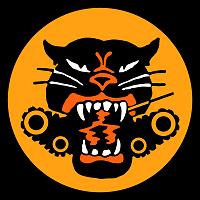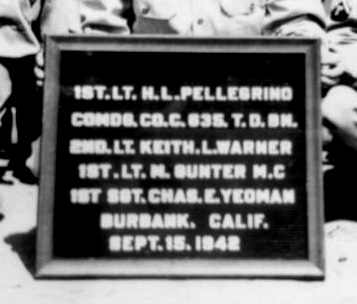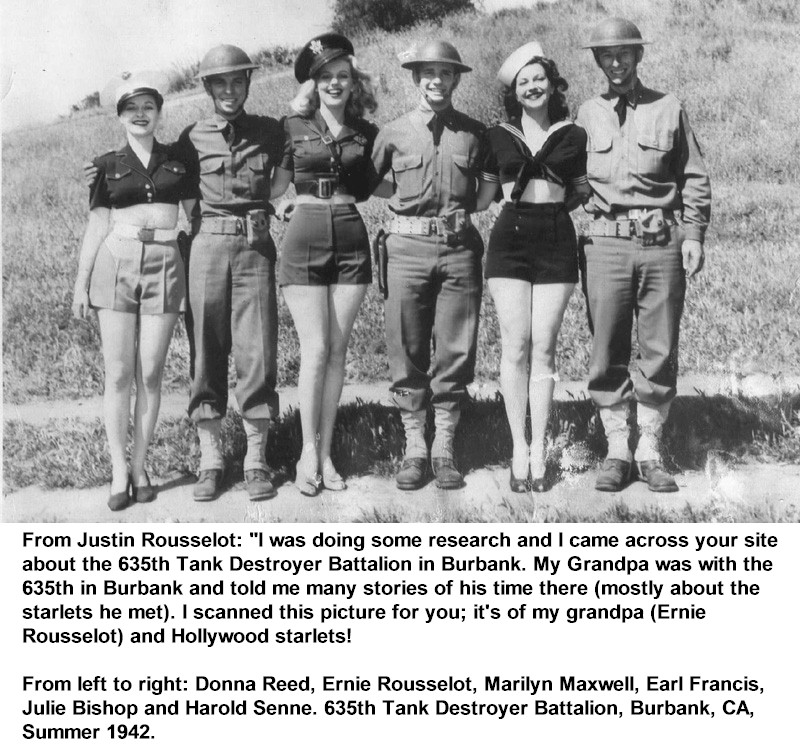

The 635th Tank Destroyer Battalion in Burbank
The full width image of this unit is here.
From a history found somewhere on the Internet:
635th Tank Destroyer Battalion
With Christmas only a few days away, on 23 December 1940 the Kansas National Guard was mobilized for a years training duty by President Franklin D. Roosevelt. In the days that followed, units from all over the state reported to their mobilization stations in preparation for the move to Camp Joseph T. Robinson, Arkansas. Once there elements of the Kansas, Nebraska and Missouri Guard would together form the 35th Infantry Division.
Troops from all four states began arriving at Camp Robinson right after the first of the year and the process of organizing and training the 35th Division began. As training progressed, the 35th Infantry Division went through a series of reorganizations to better structure the unit for the requirements of modern warfare. Among the reorganizations, was the formation of the Provisional Anti-Tank Battalion of the 35th Division.
The formation of this special purpose battalion was in keeping with an army wide reorganization, prompted by a major reaction to German strategy in 1939-1941. To be more specific, the successes of German armored units in both Western and Eastern Europe made the German panzer units seem almost invincible. The American Army decided to counter enemy armor with high velocity guns which ultimately became known as Tank Destroyers. In the wake of the Louisiana Maneuvers of 1940, the War Department pressed for the mass employment of towed high velocity anti-tank Guns as a major defense against tanks. According to army doctrine, tank destroyer units were to be fast moving elements which placed a bare minimum of their guns in fixed position and held a maximum in mobile reserve. The tank destroyer motto was "Seek-Strike-Destroy" which adequately describes their proposed mission, that of aggressive reconnaissance. The Anti-Tank Battalions were to be equipped with towed 37mm guns, in preference to self propelled pieces.
The 35th Infantry Divisions Provisional Anti-Tank Battalion was formed in June 1941 under this concept from elements of the 127th, 135th and 161st Field Artillery Battalions. In addition, support personnel to include a medical detachment (a total of 10 men) and additional clerical and ordinance personnel were included in the unit. Of the three firing elements, the 161st and the 127th Field Artillery Battalions were from the Kansas National Guard. The 135th Field Artillery was actually the Division Artillery of the 35th Infantry Division. At the time of its organization, roughly 90% of the members of the Provisional Anti-Tank Battalion were from Kansas.
As organized, the Provisional Battalion was not equipped with new high velocity anti-tank weapons but with 75mm split-trail guns which were still in the supply system from the first world war. At its inception, the Battalion was commanded by Lieutenant Colonel Wint Smith, formerly of Headquarters, 127th Field Artillery, Kansas National Guard.
The organization of the Anti-Tank force came none too soon because within a matter of weeks the battalion, together with the remainder of the division was sent south to participate in the Louisiana maneuvers held in the summer of 1941. The units mission for this exercise was to support the Blue Forces. The Louisiana maneuvers were the largest peacetime exercises ever conducted by the United States Army. Even though the Army was determined to train for its wartime mission, the rapid expansion of U.S. military forces caused critical shortages in equipment. The newly formed Provisional Anti-Tank Battalion was not completely supplied with anti-tank weapons. Companys A and B were equipped with split-trail 75mm field pieces but Company C did not have its weapons, forcing this company to simulate its mission. Despite these shortages, the battalion functioned and this exercise proved to be beneficial.
Once the maneuvers were completed, the Provisional Anti-Tank Battalion returned to Camp Robinson with the other elements of the 35th Infantry Division. It continued training with little change in status until 15 December 1941, when General Order No. 1 changed its designation to the 635th Tank Destroyer Battalion. The designation 635th was comparable to the numerical assignments given to other battalions being created at the same time. All Tank Destroyer Battalions created in this period had a 600 number.
World wide events quickly changed the status of the mobilized National Guard and the newly created 635th. On December 7, 1941, the Japanese launched a surprise attack on American forces at Pearl Harbor and within a matter of days the United States entered World War II. Given the widespread Japanese offensive in the Pacific, the American defense establishment was greatly concerned about the western coastline and rushed a number of military units to defend against a possible attack. Among the units sent west for the coastal defense was the 35th Division and its newly created unit the 635th Tank Destroyer Battalion.
The Battalion reached Fort Ord, California on 1 January 1942, and remained there until the 19th when it was moved to Camp San Luis Obispo, California. It would remain at the latter location until April 23rd when it was relocated at Griffith Park in Burbank. Its mission, like the mission of the 35th Division was to guard the coast against a Japanese invasion. During 1942 it guarded a number of defense related installations but fortunately the Japanese did not attack. The battalions' C Company commanded by Captain Harold Pelligrino received a scare one night while guarding the coast line near Fort Ord, California. Sentrys on duty spotted flashing lights along the coast and an alert was sounded with all assuming that Japanese vessels were present off the coast. Upon closer examination it was found that automobiles on the coastal highway were actually the source of the flashing lights.
Despite the lack of enemy activity, the 635th Tank Destroyer Battalion remained on duty in California approximately a year. During this period the battalion served an important function by guarding the coast against any incursion of the Japanese Army or Navy. Their period, however, of seeming inactivity caused some to call the American forces in the area "Hollywood soldiers" due to their rather plush duty on the coast. In fact, some 635th personnel were randomly selected for roles in the movie "Washington Slept Here." 35th Division personnel also landed an appearance in the film "As Thousands Cheer." The 635th served in the coastal defense mission from January 1942 until August 1942.
In August it was relieved of a portion of the defensive duties and was allowed time for various types of Battalion training with only some defensive duties. It was ordered to Camp Hood, Texas in early 1943 and from that time, the history of the 635th and that of the 35th Division diverged.
The Battalion departed from California on 15 January 1943 for Camp Hood, Texas, the newly designated Tank Destroyer Training Center. Two trains were necessary to transport the battalion and its equipment to the training site. The battalion arrived at Camp Hood on 19 January, 1943. For the next year it would remain at Camp Hood for a period of intensive training in all aspects of the role of a Tank Destroyer Battalion.
Camp Hood, Texas provided the 635th with its first intensive training as a Tank Destroyer unit. In many respects the training was similar to other units, in that physical training was stressed for all battalion members. This required hours of physical conditioning and included a traditional army activity, marching. By this time, the battalion was fully equipped with the authorized 3 inch anti-tank weapon and emphasis was placed on training and proficiency with both individual small arms and crew served weapons. In addition, intensive training was given on vehicle and ordinance maintenance, both necessary skills for the success of the battalion in a combat environment. Vehicle maintenance was particularly important because the 635th utilized guns towed by trucks or White half-tracks.
The commander of the battalion during this period and during the entire war was Lieutenant Colonel Wint Smith, originally from Mankato, Kansas. A Highway Patrol officer in civilian life, Wint Smith had originally joined the Kansas National Guard in June, 1916 and had served in a number of capacities but served by and large in the cavalry until it was phased out in 1940. Wint Smith was a strong commander who expected and got a great deal out of the men in his command. He was ably assisted by his Executive Officer, Major Carl Harder who like Colonel Smith was a Highway Patrolman and a Guardsman of considerable experience (Harder joined the National Guard in 1921). Wint Smith wanted his unit to look sharp at all times and therefore required his men to wear their leggings and steel pots at all times. They were probably the only unit at Camp Hood that consistently enforced this requirement. When committed to combat, the habit of wearing the helmet at all times, developed through Wint Smiths’ training, undoubtedly saved many lives.
The battalion, now wearing the distinctive Tank Destroyer patch, left Camp Hood on 16 December 1943 to participate in the Second Louisiana maneuvers. In a sense, by 1943, the battalion had lost some of its Kansas character. Records indicate that approximately 50% of the battalion was composed of Kansas residents and the remainder were replacements, either enlistees or draftees. It had now been mobilized for two years and was fully trained and equipped as a Tank Destroyer Battalion. The 635th was sent to Camp Polk, Louisiana for the Second Maneuvers and upon completing its field duties, the unit moved into Camp Polk containment area on 30 December 1943.
Available records fail to indicate exactly when the battalion was notified of the critical task which was being given to it. Sometime in late 1943 or early 1944, the 635th was designated as one of the units which would take part in the invasion of German occupied Europe. Thus for the first part of 1944 a substantial portion of the battalions work consisted of training personnel and preparing equipment for overseas shipment to participate in the invasion. Movement by rail to the point of embarkation began on 2 February 1944 and the 635th reached Camp Shanks on 8 February 1944. They embarked from the Port of New York on 9 February 1944 aboard a British vessel, the HMS Andes. The Andes sailed without any type of convoy escort, but in spite of this, the voyage was without incident and the Andes arrived in Liverpool, England on 19 February, 1944. Once in England, the battalion was in a Nissen hut encampment.
BIBLIOGRAPHY
1. The Bausch Family and the Mobilization of 1940, an unpublished monograph by the 102d Military History Detachment, Kansas Army National Guard.
2. COL Carl F. Harder (Ret.), A Brief History of the 635th Tank Destroyer Battalion, an unpublished study written March 1978.
3. Mary Lee Stubbs and Stanley R. Connor, Armor-Cavalry, Part I, Regular Army and Army Reserve (Washington D.C.: Office of the Chief of Military History, 1969) pp. 66-69.
4. Harold Pelligrino, former "C" Company commander in an interview with Samuel J. Newland, 102d Military History Detachment on 14 May 1985.
5. Orders and Circulars of the Adjutant Generals Office, General Order 23, (1940).
6. Movements of the 635th TD Battalion, a chronology compiled by LTC Carl F. Harder (retired), 1 March 1978.
7. Harold Pelligrino, former "C" Company Commander, in an interview with SSG Raymond Delaney on 2 June 1985.
